What will it cost you to “save gas”?
The answer can be found by reviewing the specifications of the just-redesigned 2021 Toyota Sienna minivan – which now comes only as a hybrid – with the specifications of the previous Sienna, which came only with a V6.
The new van averages 36 miles per gallon, exceptional mileage for a full-size van capable of carrying around eight people.
The previous Sienna averaged about 23 MPG.
However, the old van was capable of carrying around considerably more stuff – because it had about 50 cubic feet more capacity for cargo than the new Sienna. Which the new Sienna hybrid had to sacrifice to make room for the battery pack that powers the electric side of its hybrid powertrain.
The new van also has about 50 horsepower less – and costs about $3k more to start than the previous van – because Toyota can’t give away the hybrid side’s 650 volt nickel metal hydride battery pack and electric motor that enable this van to average 36 miles-per-gallon.
The question forms: Are the savings as you drive worth paying $3k more up front? And are you ok with the cost of losing 51 horsepower – and 49 cubic feet of cargo capacity – for the sake of 13 MPG?
The Sienna is a full-size minivan that seats 7-8, depending on the configuration. It is also the only van in the class that no longer comes standard with – or even offers – a V6.
Instead, it comes standard with a 2.5 liter four cylinder engine paired with an electric motor and battery pack. This costs 51 horsepower vs. last year’s V6, but the new Sienna averages 36 miles-per-gallon, making it the easiest-on-gas van in the class.
Base price is $34,460 for the LE trim configured for eight passengers, with a second row bench. The $39,750 XLE is configured for seven, with second row captain’s chairs. All trims can be equipped with all-wheel-drive, which gives the Toyota an advantage over its long-time primary rival – the Honda Odyssey – which comes only with front-wheel-drive.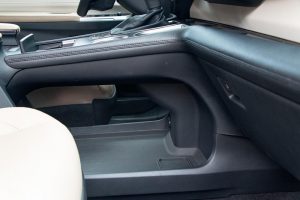
A top of the line Platinum trim with AWD stickers for $50,460.
What’s New
The Sienna has been completely revamped.
In addition to its new hybrid drivetrain, the ’21 Sienna gets revised exterior and interior styling, with the most obvious changes being the flared rear fender haunches and a new-design center console integrated with (rather than separated from) the dashboard, with the gear selector relocated there from its former position built into the dashboard.
Also – and sadly, for the budget-conscious – the former “work van” version of the Sienna, which stickered for $29,490 last year – has been discontinued.
What’s Good
Mini-car mileage in a full-size minivan.
Twice-plus the range of an electric car – without the wait of the electric car.
More shelf storage than some homes have.
What’s Not So Good
Significant decrease in power/performance vs. last year.
Less room for cargo than last year.
More expensive than last year.
Toyota has historically been a conservative car company – and one of the few major car companies to resist the trend toward ever-smaller engines, supplemented by turbochargers to make up the power lost by losing cylinders.
But the pressure emanating from the federal regulatory apparat is becoming so heavy it is becoming impossible to continue offering engines bigger than fours – even in vehicles as big as minivans. Which is why the Sienna has lost its formerly standard 296 horsepower 3.5 liter V6.
In its place, a 189 horsepower 2.5 liter four – but not turbocharged, to make up for the loss of two cylinders.
Instead, the little four is augmented – on demand – by a partially electric secondary drivetrain, consisting of a battery pack and an electric motor that summons 50-something horsepower, increasing the total on-demand power to 245 horsepower and substantially decreasing the Sienna’s consumption of gasoline.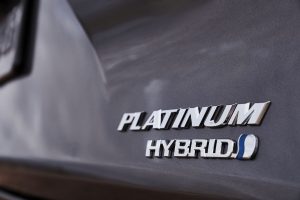
The new hybrid Sienna averages 36 MPG. In city and highway driving. Last year’s V6 Sienna averaged about 23 – because it only got 19 MPG in city driving and 26 on the highway.
During a week-long test drive, I consistently averaged 29.8 MPG, driving the way I drive – which is much faster and “furiouser” than the average person drives. The mileage gains are without question considerable.
But they come at a cost.
The new hybrid Sienna is much less powerful than its predecessor. It is down 50-something horsepower vs. last year and that can be felt, every time you push down on the accelerator pedal. The hybrid Sienna needs about 8 seconds to get to 60 MPH, which isn’t slow as such (unlike a Prius hybrid, which is very slow) but it is noticeably slower than last year’s V6 Sienna, which could do the 0-60 spring in less than seven seconds.
The V6 Sienna, however, could not move at all unless its engine was running.
The new Sienna hybrid can be driven – with a light foot – up to about 20 MPH and for about a mile as if it were an electric minivan, which it is. At least part-time. The gas side also shuts off when you’re not moving and when you’re coasting – and this is how you average 36 MPG in a a 4,600 lb. 7-8 passenger minivan.
It’s also how you keep going for more than 600 miles – something no full-time electric vehicle is capable of doing. And because the Sienna recharges itself – using the little four cylinder gas engine as a generator as well as a source of motive power – you only have to stop for long enough to feed it more gas, which takes a lot less time than feeding an electric vehicle juice.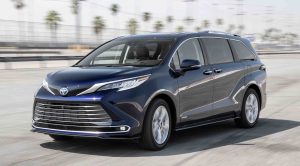
On The Road
Hybrids are at their best in traffic, when you aren’t moving very fast and often, not at all. They are better than non-hybrid modern cars, almost all of which are afflicted by “stop-start technology,” which automatically shuts off the engine practically every time the vehicle stops moving – and then restarts it (after a slight but noticeable delay and noticeable sounds and sensations). This gets really old, really quickly – and it is why most owners of cars so afflicted use the Off button to keep the engine on.
Hybrids, of course, usually cycle off their engines when the vehicle isn’t moving. But the key difference is they can get moving, again, without needing to cycle on the engine. It does come on, as speed builds – or the pressure applied by your right foot increases – but now you’re already moving and so the engine re-start is much less noticeable, if you happen to be aware of it happening at all.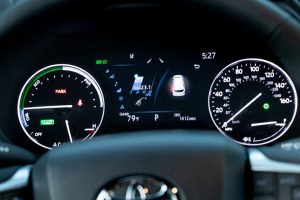
The main thing you will be aware of is having to apply more pressure to the accelerator to get moving quickly. The previous V6 Sienna felt much stronger, with less pedal effort. Because of course it was.
Lighter, too.
Another cost of going hybrid is added weight. The least-heavy version of the new Sienna is 4,610 pounds. The heaviest – the AWD-equipped versions – weigh a spectacular 4,725 pounds. For reference, the previous V6 Sienna’s curb weight was a mere 4,430 pounds.
But, you can go much farther in this hybrid than you could go in the old V6 Sienna, which had a maximum highway range of 520 miles – and just 380 miles in city driving. The hybrid can travel 648 miles on the highway and in the city.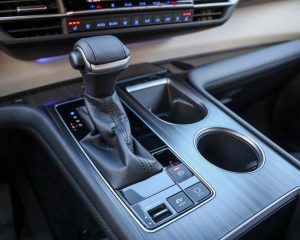
In everyday practical terms, this means you’ll probably need to stop to fill up one less time each month, vs. the old Sienna. It also means having to wait far less than you would with a purely electric car, only a few of which can go half as far as this hybrid can – and which take at least five times as long to get going, again.
The main downside is the increased noise coming from the harder-working gas engine when you’re wanting to get going quickly. This is exacerbated by the also-new continuously variable (CVT) automatic transmission, which replaces the old V6 Sienna’s eight speed automatic. CVTs don’t shift through gears; they continuously vary the range, via a belt that rides higher or lower in a set of pulleys, to increase or decrease the mechanical leverage.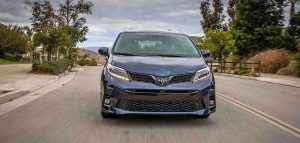
Under heavy pressure from the accelerator pedal – which is necessary to get moving quickly, in a vehicle with not much engine – the CVT will adjust to extract the maximum power from the engine, which is usually at or near the engine’s redline. And hold the engine RPMs there, until you decrease the pressure on the accelerator. This results in more drivetrain noise than would be produced by a stronger engine that didn’t need to be revved as high to get you moving – paired with a transmission that downshifted to a lower gear once you got going, reducing the engines revs – and noise.
On the flip side, the hybrid Sienna is quieter when it’s not moving – or not moving much – because its engine is typically off.
At The Curb
The new Sienna’s looks are much less radical than its mechanicals. There are differences, including the rabbit hips over each of the rear wheels – and a less boxy profile from the side – but they aren’t obvious enough to call attention to themselves, unless you’re looking for them.
The big differences – beyond the mechanicals – are inside.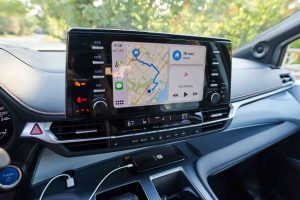
Though the new van is about the same size as the old van – and still seats 7-8, according to which seating configuration you select – it has less room behind its third row (down to 33.5 cubic feet from the previous 39.1 cubic feet) and with both its second and third rows stowed (down to 101 cubic feet from 150, previously).
The reason for that being the battery pack and electric motor – which had to be put somewhere. This costs the Sienna a sales point relative to roomier (for cargo, at least) non-hybrid rivals such as the Honda Odyssey, which has 155.7 cubic feet of total capacity and 38.6 cubic feet behind its third row. The Chrysler Pacifica and the new Kia Carnival (my review is here) also have considerably more total cargo capacity, 140.5 and 145.1 cubic feet, respectively.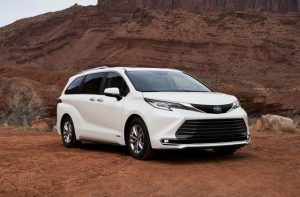
There are some other – more positive – differences that distinguish the new Sienna from the old Sienna. Chief among these is a new dash/center console layout – the latter arranged like shelves, with a huge and easily accessible under-shelf storage area topped by another shelf that is a very convenient place to toss keys and charge your phone. There’s a wireless charger built into the forward area of the shelf, which extends laterally toward the front passenger’s side of the dash. The console top has four big cupholders and a huge (and deep) storage well, with offset armrests on either side
The gear selector has also been moved to the console, which feels more natural than the previous Sienna’s dash-mounted lever. More agreeable is the slightly canted – toward the driver – secondary LCD touchscreen, which makes it ever for the driver to use and to see, because the angle helps reduce glare.
And there is still a 12V power point – in addition to modern-device USB charge ports – which means you can plug in your old-school devices as well as your new ones. You’ll also find a 120V three-prong outlet mounted on the backside of the center console, facing the second row. This can be used to power higher-draw appliances, such as portable ‘fridges and so on.
You can get things like captain’s chairs with extendable footrests and an excellent 12 speaker JBL audio rig but similar things are available in rival vans. The one thing the Sienna has which most of them don’t even offer is the hybrid layout – excepting the Pacifica, which is available with the hybrid layout. But the Pacifica hybrid costs so much – $46,145 to start and its mileage is so poor – it only averages 30 MPG – that the Sienna doesn’t have much to sweat from it as a potential rival.
The thing Toyota may end up sweating is the lower cost of non-hybrid rivals like the Odyssey and Carnival, which sticker for $32,290 and $32,100 to start, respectively – and come with more engine – and more room.
There is also one other thing – that Sienna buyers may end up sweating. 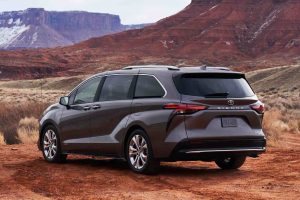
Every battery yet devised gradually loses its capacity to hold as much charge as it could when it was new, the inevitable result of degradation over time caused by regular discharge/recharge cycling. Hybrids are less susceptible to this degradation because their batteries are kept topped-off by the system and because they are used less – because there is a gas engine to carry much of the load of powering/propelling the vehicle.
But batteries do wear out – and when they do, they cost a lot to replace. It may not happen for ten years – or even fifteen. But it will happen. And when it does, the cost to fix may not be worth keeping the van.
The Bottom Line
One thing’s for sure about the new Sienna. It is different.
Whether for better or worse – for Toyota – the market will decide.
. . .
Got a question about cars, Libertarian politics – or anything else? Click on the “ask Eric” link and send ’em in!
If you like what you’ve found here please consider supporting EPautos.
We depend on you to keep the wheels turning!
Our donate button is here.
If you prefer not to use PayPal, our mailing address is:
EPautos
721 Hummingbird Lane SE
Copper Hill, VA 24079
Also, we do accept Crypto. If you’d like to donate that way, please email EPeters952@yahoo.com for details.
PS: Get an EPautos magnet or sticker or coaster in return for a $20 or more one-time donation or a $10 or more monthly recurring donation. (Please be sure to tell us you want a magnet or sticker or coaster – and also, provide an address, so we know where to mail the thing!)
My eBook about car buying (new and used) is also available for your favorite price – free! Click here. If that fails, email me at EPeters952@yahoo.com and I will send you a copy directly!





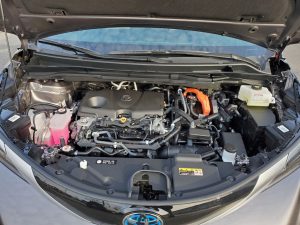

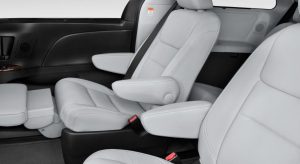







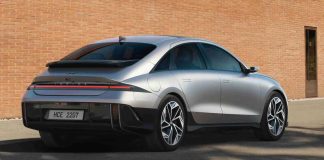
I have two Siennas from 2006 and 2009. The big selling point of these are the huge interiors. I can slide in 4×8 sheets of plywood, a huge load of two by fours, or stones for landscaping with a quick fold down of of the seats. With the interior dropping from 150 to 100, how much can even fit inside these vans now? It sounds like it will be like a Yukon or Suburban, huge on the outside but the reality is the back seat is crammed and uncomfortable
Hi Paul,
You bring up a very valid point; in addition, there is this hybrid-only business. One of the prior Sienna’s great strengths was the superb 3.5 V6. These engines are strong and reliable. It is tragic they’re being replaced by that which isn’t.
First the bad news: It won’t be long before you could lock me in a new vehicle and I wouldn’t know how to drive it or even get out.
The good news is that it won’t be long before I can lock the bastards in my old 1999 S-10 manual 5 and they won’t know how to drive it or even get out.
We need a good old-fashioned roundup.
‘the slightly canted – toward the driver – secondary LCD touchscreen’ — eric
I can’t help snickering at the disproportionate size of these screens, which have gone from emulating cell phones to mirroring the 85-inch TeeVees that owners bring home from Costco these days.
Though the graphic on the LCD touchscreen (third photo) probably is a map, it could be mistaken for a chart of the S&P 500 index relentlessly soaring ahead of its 200-day moving average.
Alexa … buy me another hundred shares of Tesla!
Hi Jim,
I know; I share your dislike of these things. Or rather, I feel no need for them and do not want them, myself. But – like the “vaccines” – millions of people do. And they are driving this…
EP: “I really like Toyota’s 3.5 V6.”
Agree – I have two vehicles with that engine. I think of the 3.5 as the replacement for the Chevy small block V8 of which I previously had many. All my Chevy engines consumed more oil than the 3.5, which essentially consumes zero oil, and has been trouble-free.
Another, equally good Japanese engine, is the 3.7 in the Infinity G37. It makes ~ 330hp – no turbos, AFM, etc.
Amen, Anon –
It’s such a shame. The IC engine is so good now. Of course, that explains why it must be forbidden. The one thing the masses must not be allowed is inexpensive, long-lasting personal mobility. Or, for that matter, energy. It allows to much independence. Too much liberty.
Great review Eric! That old 3.5 v6 runs for a LONG time too….maybe considerably longer than Toyota was planning on when they released it. Very reliable, even if you’re hard on it. I once beat a friend in a 1/4 mile with a 2006 sienna. He was driving a 328i sedan of similar age. 50 less HP AND more weight?! Not a smart move for family trips through switchback mountain roads out west. The 650 miles on a “tank” is quite a redeeming feature, but not worth the $ cost and the loss of power to me. Knowing it only gets that from a battery that will need to be replaced? Well, that excludes it from my options as I like to drive a vehicle until much longer than that.
The new dash/center console layout arranged like shelves, with a huge and easily accessible under-shelf storage area, etc… sounds kind of nice.
Being able to power higher-draw appliances, such as portable ‘fridges and so on sounds really good, too.
Howevah; That. Is. One. Ugly looking space shuttle! ‘er I mean car, ‘er van, oh wait, mini-van. It’s no Woody, that’s fer sure.
I did not know the older versions had a gear selector built into the dashboard. That will be trippy the first time I see one.
The review was a nice diversion from the end of the day.
I don’t see it helping sales of them at all (same with the downsized Tundra too). Minivans are a hard sell to begin with most folks, and this won’t improve it. If they had been able to hold the line on the price, maybe, but its a big increase for what is a lessor vehicle.
Now if uncle would actually allow an actual market, Toyota could continue to offer a V6 model as well, and let the buyers decide, but you know……
Of course if there was an actual market, there probably wouldn’t be hybrids or electric cars from the big automakers to begin with.
Doesn’t seem like a good trade off
Hi Dan,
I really like Toyota’s 3.5 V6. It is arguably one of the best engines of the past 30-plus years. There is no good reason to replace it with a hybrid drivetrain. But there is a bad reason. One guess as to what that is.
Wonder how much longer they will offer the V6 in the Camry (or Avalon). Guessing not too long.
Yes sir. Two things are ruining vehicles currently. The worst at the moment is fake environmentalism.
Like richb commented, how long until there is no such thing as a V6 anymore?
I like new tech, but only when it adds to the end product.